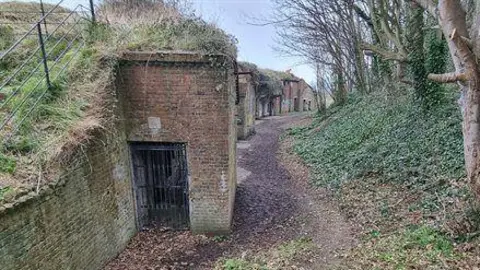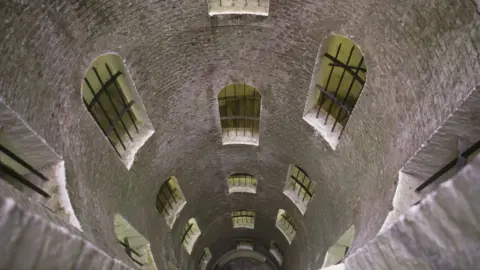Forts from Napoleonic Wars being restored
 Dover District Council
Dover District CouncilA series of hilltop forts built to defend England during the Napoleonic Wars are being preserved to ensure their legacy can live on.
The Western Heights comprise a number of forts linked by miles of ditches on the western hilltop above Dover, Kent.
It is one of the most important fortifications in Britain and was used as barrack accommodation during World War One and Two, however had become overgrown and a hotspot for antisocial behaviour in recent years.
But teams are now one year into a three-year project to remove vegetation and restore the land, which is revealing hidden buildings and making the area safer.
Western Heights began as field fortifications during the American Revolutionary War, was strengthened and extended during the French Revolutionary and Napoleonic Wars, extended again in the 1860s and completed in the 1890s.
Among the most impressive features is the Grand Shaft, built in the Napoleonic Wars to link the barracks on Western Heights to the harbour.
 Getty
GettyParts of the site, however, were neglected, but after a joint grant of £298,000 from Historic England and Dover District Council, extensive work has been carried out by Western Heights Preservation Society and White Cliffs Countryside Partnership to bring them back to life.
Most recently, the Gun Shed area, which had been a target for antisocial behaviour, has been cleared and vegetation removed from buildings at St Martin's Battery.
There is now also signage and solar-powered CCTV on site.
Lynne Wright, the council's member for corporate property, said: "The Western Heights is one of the district's most impressive sites and we are using this project to help us better understand its significance and wider importance to the town."
Ms Wright added that the project was an opportunity to "enhance and continue to protect the area, and to maintain it as a destination of national and international significance".
Restoration works are expected to continue for another two years.
Follow BBC Kent on Facebook, X and on Instagram. Send your story ideas to [email protected] or WhatsApp us on 08081 002250.
